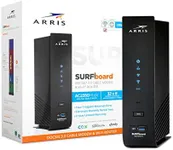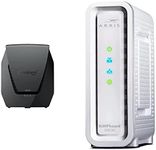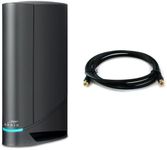Buying Guide for the Best Comcast Approved Modems
When choosing a Comcast-approved modem, it's important to ensure that the modem is compatible with your internet service plan and meets your specific needs. A good modem can significantly improve your internet speed and reliability, so it's worth taking the time to choose the right one. Here are some key specifications to consider when selecting a Comcast-approved modem and how to navigate them to find the best fit for you.DOCSIS StandardDOCSIS (Data Over Cable Service Interface Specification) is a standard that determines how data is transmitted over cable networks. The most common standards are DOCSIS 3.0 and DOCSIS 3.1. DOCSIS 3.0 is suitable for most users with standard internet needs, offering speeds up to 1 Gbps. DOCSIS 3.1 is the latest standard, providing faster speeds (up to 10 Gbps) and better performance for high-demand users, such as gamers or households with multiple devices. Choose DOCSIS 3.0 if you have a basic internet plan and DOCSIS 3.1 if you have a high-speed plan or need future-proofing.
Channel BondingChannel bonding refers to the number of downstream and upstream channels a modem can use simultaneously. More channels mean better performance and higher speeds. For example, a 16x4 modem has 16 downstream and 4 upstream channels, which is sufficient for most users with moderate internet usage. A 32x8 modem offers more channels and is better for heavy internet users or those with high-speed plans. Consider your internet usage and choose a modem with enough channels to support your needs without overpaying for unnecessary capacity.
SpeedThe speed rating of a modem indicates the maximum download and upload speeds it can handle. This is usually measured in Mbps (megabits per second) or Gbps (gigabits per second). Ensure that the modem's speed rating matches or exceeds the speed of your internet plan. For example, if you have a 200 Mbps plan, a modem rated for 300 Mbps or higher will be sufficient. If you have a gigabit plan, look for a modem that supports speeds of 1 Gbps or more. Matching the modem speed to your plan ensures you get the best performance without bottlenecks.
CompatibilityNot all modems are compatible with all internet service providers (ISPs). Comcast has a list of approved modems that are guaranteed to work with their service. Before purchasing a modem, check Comcast's official list of approved devices to ensure compatibility. This will save you from potential issues and ensure you get the best performance from your internet service. Always verify the modem's compatibility with your specific Comcast plan to avoid any disruptions.
Built-in RouterSome modems come with a built-in router, offering a two-in-one solution for both modem and Wi-Fi needs. This can save space and reduce the number of devices you need. However, built-in routers may not offer the same performance or features as standalone routers. If you have a small home or basic internet needs, a modem with a built-in router can be convenient. For larger homes or advanced networking needs, a separate modem and high-quality router may provide better performance and flexibility.
Future-ProofingTechnology evolves rapidly, and investing in a modem that can handle future upgrades can save you money in the long run. Look for modems that support the latest standards (like DOCSIS 3.1) and higher speeds than your current plan. This ensures that your modem will remain compatible with future internet speed upgrades and new technologies. If you plan to upgrade your internet plan or expect higher internet demands in the future, choosing a modem with advanced features can be a wise investment.













